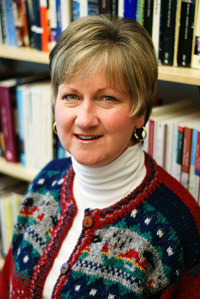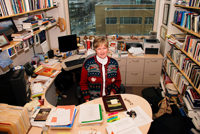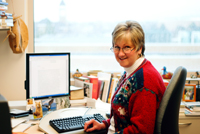Susan Howe

How did you get started writing?
I suppose I started writing by reading, which has always been a great pleasure to me. I had such a great appreciation for how novels both expanded my world and helped explain me to myself that I felt them to be of extraordinary value. I wanted to see if I could write anything as worthwhile as I found Jane Eyre or Huckleberry Finn. But I was a late beginner, taking no classes until after I graduated from college. Then I thought, rats! I should have majored in English and minored in drama, not Spanish and French.
When did you first start writing poetry?
The first poem I remember writing was a part of my high school graduation speech. It was something didactic about how our graduating class should act to bring about the changes we wanted to see in the world—not very poetic except that it rhymed. I wrote a notebook of poems the summer after my freshman year of college. But I only became serious about writing poetry when I began my master’s program in creative writing at the University of Utah.
How do you get ideas for poems?
The majority of my poems come from observation. I have never done very well with poems about my emotional life, but I am often intrigued by a brief article in a newspaper. For example, I’ve written a poem about a rhinoceros at the Hogle Zoo that tripped, got wedged under a rock ledge, and smothered, and another about a woman whose pet python wrapped itself around her and started to squeeze—both poems originating with newspaper articles. I often write about the natural world, particularly Utah’s redrock canyons and the rural day-by-day life of Sanpete County, where I live.
What’s your writing process like?
I require absolute silence and solitude to write, and I prefer a desk near a window, sometimes at home when no one else is there, more often in a library. I begin by reading the poems of someone whose work I admire, because that moves me into a creative space where I am aware of and sensitive to language. Then I compose a new poem (or at least the beginnings of a new poem), and finally move on to revising poems that are in one stage or another, usually working on about five poems in one writing session.
One of my teachers said in class once, “Anything doing is worth doing poorly,” which has always been a great comfort to me as I begin a poem. I have to lower the stakes to give myself permission to write, because the first images and language that come are usually clichéd. But it’s only by writing what comes first without censoring it that I am able to get through to my own vision and language. Another teacher taught me that a poet should ask herself what language seems necessary to present or to interrogate her subject, and that’s what I focus on—what language is necessary for this subject? I don’t write in lines or sentences, but phrases and images. I write all over the page, in no order. Once I have amassed one or two pages of language, I pull it together into the shape of a poem.
As for completing a poem, that seems harder and harder the more I write. I’ve learned that a poem must give the reader an emotional pay-off, which is difficult to bring off without sentimentality. Emotion has to be earned, and the poem has to get the reader to invest in the situation, so that the reader can feel with the poem. If there’s no risk for the writer, there will be no response in the reader. Once in a while a poem seems to shape itself easily, but often it takes me a long time to create the necessary movement in the poem that will create the emotion. After I’ve worked on a poem for several weeks, I’m too close to tell what the actual language is doing; I read my intentions rather than what’s actually on the page. Then I have to put the poem away for a while so that I can come back to it as a reader and feel whether it is working or not. It does no good to refine the language and line breaks if I’m going to have to slash and burn large sections and fill in with new content.

How did you get your first poem published?
My poems were first published in LDS periodicals—Exponent II and Sunstone. I had a poem accepted by the Ensign, but they asked me to change what I thought was the central and necessary image, so I withdrew the poem. As for national publication, in my PhD program I had a great friend, George Bilgere, who was a superb poet. I brought my whole sheaf of poems to breakfast with him one day, and he read them, grouped them, and told me where to send them. He suggested journals that published a lot of poetry, because there is a higher possibility of acceptance if the journal publishes twenty or thirty poems an issue rather than five or six. I sent the poems out exactly as he had suggested, and Kansas Quarterly accepted two.
How do you know when a poem is ready to be seen by a publisher?
The journals themselves tell you to read a few issues and get a sense of what they publish. I try to send poems to journals in which I have found many poems that I admire, because it is more likely that my work will appeal to editors who publish work that I like. Usually, a journal submission is four or five poems, and I try to send poems of varying lengths and subject matter, a range of work, so that one or two might fit the needs of the journal if the rest don’t.
How does writing poetry influence your other writing?
That’s an interesting question. Writing poetry involves caring immensely about individual words, about how language works, about what pressures can be exerted on language to make it surprise as it communicates. Such attention ought to improve any writing. I’d also say that the tightness of poetry has taught me to edit so that I say exactly what I mean and don’t repeat myself.
What classes do you teach? How has teaching influenced your writing?
I teach a variety of classes, both literature and writing. They all give me the opportunity to read some of the best novels, stories, and poems. I learn something about how to write every time I re-read a text, so in that sense, teaching has been a great benefit to me. It is also very rewarding to work with young poets in writing classes because they value poetry as much as I do, and there’s nothing like having a community. Poets are sort of the monk seals of contemporary culture; we spend a great deal of time wandering the boundaries alone. It’s affirming to find others of one’s kind in the world.
How do you balance writing with teaching and family responsibilities?
Not very well. I always wish there were three of me, so that I could meet all the responsibilities I need to meet. I struggle like everyone else in this culture, fragmented and stressed too much of the time. At BYU, I work most nights until ten, so that when I go home to Ephraim on the weekends, I can spend the little time I have there with my family. I can get in the occasional hour of writing by staying up late or by making an appointment with myself to write. But for the past couple of years, I’ve done most of my writing during the summer months when I’m not teaching and can actually make choices about how to spend my time.
How do you feel about reading your poems aloud?
I like to read my poems aloud and practice reading so that I will communicate effectively with the audience. It is useful to explain the genesis of a poem and any obscure references it makes. The last time I read at BYU, I included several poems about life in rural Sanpete County, and I felt I had communicated when several audience members who had lived in similar rural communities came up to say they recognized the turkeys, the sheep, and the magpies in my poems.
Have you found any common themes cropping up in your work?
I mostly write in a woman’s voice about women’s experiences. I have many poems that make use of a persona who is not me, all of them women in various circumstances. Another strand of my work is about the natural world. I am in awe of the Utah landscape and hope to contribute to poetic representations of that landscape worthy of its strength and endurance, as well as representations of what it is like to live here and how this land has become home for us and our faith.
How do you see poetry building the kingdom?
I think that humans come to understand principles by experiencing actual, physical situations. We learn about the importance of being dependable, for example, when we disappoint someone who is counting on us. As life is greater than individuals, we also learn by imagining what we have not personally experienced. Another example: how do we learn what Christ is like and what it must be to talk with Him? We imagine ourselves doing it, and that act of attention makes it possible for the Spirit to enter our hearts and let us feel Christ’s love. Or how do we forgive someone who has wounded us and isn’t the least bit sorry—the most difficult individual to forgive, but not excluded from Christ’s injunction—unless we are able to imagine the world from the perspective of that offender, to feel the lack and need and fear that caused him or her to strike out? Imagination, as I have experienced it, can be part of and lead to spiritual growth, and imagination is the natural province of the poet. A poet’s range is something of a gift, and a poet has to work within that range, but each poet can express something of the complexity and depth and eternal value of human experience.
What other writers have influenced your work?
I could go on and on, but let me just say Elizabeth Bishop, and especially the poems “Seascape,” “At the Fishhouses,” and “The Moose.” In each of these poems, there is a transformation of an ordinary moment of observation into an imaginative perception of spiritual truth. I have read these poems again and again, and I’m still not sure how Bishop achieves such a leap, but she does. She has accomplished in these poems the very task I would like to achieve.
Do you have any favorite Mormon poets?
Many. I have immense respect for the poets at BYU: Lance Larsen, Kimberly Johnson, John Talbot, Scott Hatch, Michael Hicks, and Steven Graves. The Discoveries project created in me a sense of sisterhood with a group of very fine LDS women poets, including Emma Lou Thayne, Dixie Partridge, Marilyn Bushman-Carlton, Elaine Christensen, Mary Lythgoe Bradford, and so many other women. There seems to be a real flourishing of Mormon poetry and poets in the last few years. I’ve also taught several students who will be far better than I am, young poets with both the talent and work ethic to make significant contributions to American poetry and to Mormon poetry.
How does being Mormon affect you as a poet?
I agree with Flannery O’Connor’s advice on the subject of the influence of religion on a writer. She says, “Your beliefs will be the light by which you see, but they will not be what you see and they will not be a substitute for seeing.” I hope that my beliefs are the lens through which I see the world and that my way of seeing informs how I address my subjects, but I have to look directly at the subjects. I’m not trying to preach the gospel, as that isn’t the work of poetry.
Tell us about Discoveries.
Discoveries: Two Centuries of Poems by Mormon Women was a project suggested by Jill Mulvay Derr as part of the celebration of the 200th birthday of Eliza R. Snow. Jill invited Sheree Bench and me to create a reader’s theater of poems by Mormon women from both the nineteenth and twentieth centuries. We decided to choose poems that represented the entire arc of a woman’s life, from pre-mortal existence to birth and finally ending with death and entrance into eternity. The reader’s theater grew into a full production with original music by Harriet Petherick Bushman, a wonderful LDS composer from England. Because we found more really excellent poems than could be included in the dramatic program, we published the book as well. Then the production was transformed into a DVD, and now a second edition of the book is being printed by BYU Studies, this one hardcover with four-color illustrations.
Discoveries was the most gratifying project I have ever worked on. All sixty-five women involved (poets, singers, actors, production team, editors, etc.) felt very committed to its success and used their talents to the fullest. And I felt there was a spiritual truth to what we created, a look at the whole arc of a woman’s life, including struggle and sorrow as well as humor and joy.

How was publishing your book Stone Spirits a different experience from your previous experiences getting work published?
The attempt to publish a collection comes after a poet has placed about half the poems of the collection in literary journals. Once I had the poems and the publications, I read about a hundred collections, talked to other poets, and learned that the way the poems are arranged can either make or break a book. My book came into being when I went with a dear friend, Sue Booth-Forbes, to a New Hampshire retreat on a lake. One afternoon we sat by a stream and together read my poems one by one and found sequences of poems that were relevant to each other. We created the essential shape of the collection that day. Once it was in place, several poet-friends read the manuscript and made suggestions about what to drop and what to rearrange, and the manuscript finally became something I was happy with and willing to send out to publishers.
Many of your poems in Stone Spirits are clearly based on personal experiences you’ve had, others less so. What inspired you to write poems like “Tiger Eating a European” and “The Stolen Television Set”?
“Tiger Eating a European” is about a carved and lacquered wooden sculpture in the Victoria and Albert Museum in London, a real artifact commissioned for himself by an Indian maharajah during the British colonial period. I thought it expressed eloquently how the Indians really felt about the presence of the British. “The Stolen Television Set” came from a story on the evening news about someone taking the television set from a local home for the elderly. A few of the residents who were interviewed seemed so desperate that I began thinking about our culture’s addiction to television as a way to distract and entertain us, and to even create meaning in our lives.
What was it like writing “Mary Keeps All These Things”?
You know, I don’t remember the process of actually writing the poem, but I clearly recall the impetus. It occurred to me that in my whole life I had never heard the story of the birth of Christ from the perspective of his mother, who was so centrally involved. Why couldn’t she speak? Where was her voice? My poem is my attempt to imagine what it was like for her to travel with Joseph, to realize that she was about to deliver, to seek shelter anywhere before her baby was born. For Mary’s sake, it is one of the poems I am happy to have written.
Do you have plans for other books and collaborative projects?
As a matter of fact, Harriet Bushman is writing a song cycle for “Mary Keeps All These Things,” and since I think she is amazingly talented, I am very excited about that project. I also have a collection of poems entitled Salt that I am currently circulating in search of a publisher. I am interested in writing a sequence of poems about the life of my mother, who has Alzheimer’s and has to stay in a care facility. I also have a couple of plays in mind, should I ever get the time to write them. ❧
